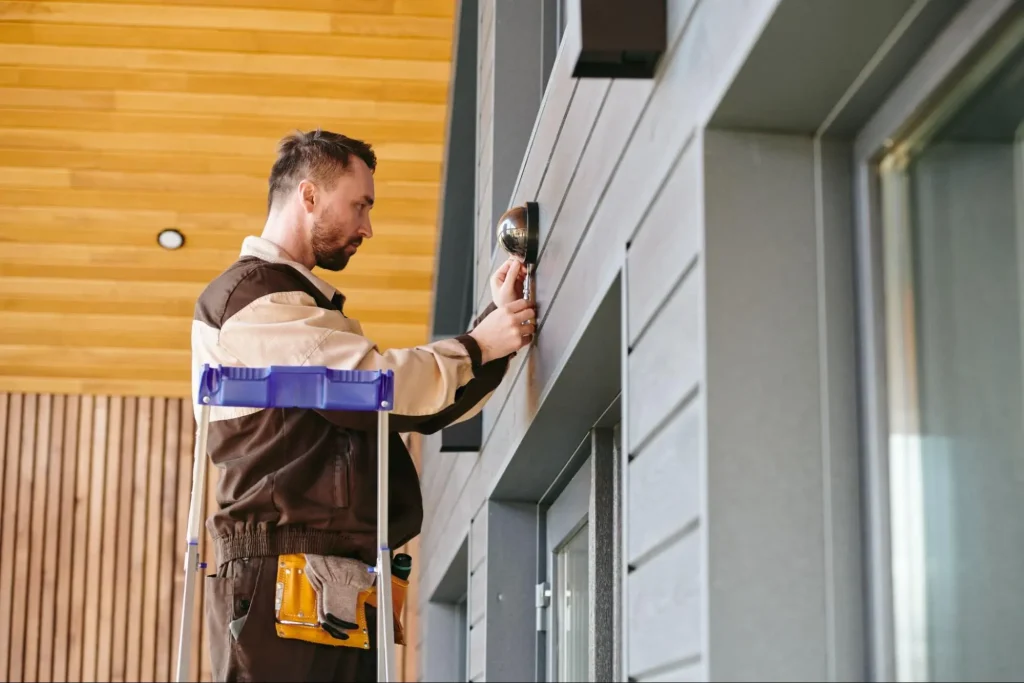
When it’s time for handyman services, taking some steps beforehand can make the process smoother for both you and the handyman. Clearing the workspace is crucial; it ensures the handyman can move around easily and reduces the risk of accidents. This might mean moving furniture out of the way or tidying up the area where the work will be done.
You’ll also want to have any necessary tools or materials ready. Many handymen bring their own tools, but it doesn’t hurt to check if specific items are needed for your project. If there are any specific requirements for the job, such as paint colors or types of flooring, having these ready can save time and prevent delays.
Communication is key. Make sure to discuss all the details of the job beforehand so there are no surprises. Whether it’s a simple repair or a more complex installation, knowing what to expect will give you peace of mind and help the handyman do the job efficiently.
Before the handyman arrives, you need to take steps to make the process as smooth and efficient as possible. These preparations can help minimize disruptions, protect your belongings, and ensure the professional can get the job done quickly.
Clear the area where the handyman will be working. Move furniture, toys, or any other items that could get in the way. This not only provides more space for tasks like furniture assembly but also makes it safer for everyone involved. A clean, clutter-free space helps the handyman work more efficiently and reduces the risk of accidents. If possible, store these items in another room until the job is complete.
Make a detailed list of the tasks you need to be done. Write down each project, along with any specific instructions or materials you think might be needed. This list helps you stay organized and ensures nothing is overlooked during the visit. Sharing this list with the handyman ahead of time can also help them prepare better, bringing the appropriate tools and supplies. A clear project list eliminates confusion and helps the handyman complete the work to your satisfaction.
Ensure all areas where the handyman will be working are easily accessible. This might include unlocking gates, clearing driveways, and providing access codes if needed. If the work involves plumbing or electrical tasks, make sure the corresponding access points are clear and easy to reach. This saves time and helps the handyman get started right away. In some cases, you may need to move items or furniture that block key areas.
Cover or remove valuables in the work area to prevent damage. This includes fragile items, electronics, and anything of sentimental value. Use drop cloths or plastic coverings to protect furniture and floors from dust, paint, or debris. If the handyman will be doing more extensive work, consider moving valuable items to a different room altogether. Taking these precautions helps you avoid unnecessary stress and keeps your belongings safe during the project.

Preparing your home for handyman services begins with understanding key maintenance tasks and repairs. Regular inspections, knowing common repairs, and prioritizing tasks can keep your home in top condition.
Regular inspection of your home can prevent small issues from becoming big problems. Check your gutters for blockages or damage, especially after heavy rainfall. Clean them to prevent water damage to your home’s foundation. Inspect your roof for missing or damaged shingles and repair them to avoid leaks.
Doors and windows should also be inspected. Ensure they open and close properly and seal any gaps to improve energy efficiency. Regular maintenance of plumbing and electrical systems can help avoid emergencies. Look for any leaks or unusual sounds and fix them promptly. Regularly reset any tripped breakers following easy steps to ensure safety.
Common repairs around the house often include fixing leaks, repairing damaged surfaces, and addressing electrical issues. Leaky faucets and pipes can lead to extensive water damage if not fixed. Tighten or replace old fittings to stop the leaks.
Cracks or gaps in walls can be unsightly and lead to more serious structural issues. Use seam sealer or white glue to fix these, then smooth over the area. Electrical issues such as tripped breakers are also common. Learning how to reset a breaker properly is an essential skill. Keeping an eye on these common areas can save you time and money on larger repairs.
Some tasks need attention more urgently than others. Urgent tasks often include anything that affects safety or critical functions, like plumbing or electrical issues. Address these immediately to prevent further damage.
Next, focus on tasks that improve energy efficiency, such as sealing drafts around doors and windows and replacing old insulation. These can lower your energy bills and make your home more comfortable. Routine maintenance tasks, like cleaning or minor repairs, should be done regularly to prevent larger issues.
A well-maintained home looks better, lasts longer, and functions more efficiently.

Hiring a skilled and reliable handyman involves several important steps. Verifying credentials, comparing costs and quality, and reading reviews and ratings are crucial to ensure you hire a professional who meets your needs.
Before hiring a handyman, check their credentials. Ensure they have the necessary licenses to work in your area. Licensing shows that they meet local standards and regulations. Also, confirm the handyman is insured. This protects you from liability if accidents happen on your property. Look for general liability insurance to cover potential damages or injuries.
Experience matters, too. Ask how long they’ve been in the handyman service business. More experience often means better skills and reliability. Verify past projects to gauge competence.
Compare prices among various handymen. Prices typically range around $60 to $65 per hour depending on location and experience. While it’s tempting to go for the cheapest option, remember that cost often reflects quality. A more experienced, professional handyman might charge more, but the investment can save you money on future repairs.
It’s important to get detailed bids from potential handymen. A thorough bid shows they take the job seriously and helps you understand the cost breakdown.
Read reviews and ratings online to find a reliable handyman. Look at ratings on platforms like Google, Yelp, and Angie’s List. High ratings and positive reviews are good indicators of quality service. Pay attention to feedback about punctuality, professionalism, and quality of work. Look for patterns in the reviews. If multiple customers praise their reliability and skill, it’s a good sign.
Be cautious of handymen with consistently poor reviews or unresolved complaints. This could indicate potential issues with their service. Always choose a handyman with a proven track record of customer satisfaction.
Routine maintenance is essential to prolong the durability of recent repairs and improvements. Create a simple checklist to keep track of tasks. For example, regularly check the hinges and locks if new doors were installed.
Proper maintenance can reduce energy usage and increase the efficiency of home systems. Keep an eye on areas like plumbing and electrical work. This helps prevent small issues from turning into costly repairs. Ensure that any changes made to the property align with home insurance requirements.
Regular handyman visits can prevent long-term damage and maintain home efficiency. Keep a log of previous services and identify patterns that indicate when future visits should be scheduled. Common tasks that may require periodic attention include tree trimming, caulking, and painting.
Consider the frequency of needed work based on factors such as climate and home age. Setting up a regular maintenance schedule with your handyman can ensure small issues are caught early. Discuss potential tasks for future visits, especially for seasonal needs or before major weather changes.
Preparing your home for handyman services involves several key steps to ensure everything goes smoothly and efficiently.
Clear the Workspace: Make sure the areas where the handyman will work are free of clutter. This allows the handyman to move around easily and prevents damage to your belongings.
List Your Priorities: Create a clear list of tasks that need to be completed. Prioritize them to make sure the most important jobs are handled first.
Communicate Clearly: Discuss your expectations and specific requirements with the handyman. Clear communication helps prevent misunderstandings and ensures the job is done to your satisfaction.
Secure Pets: If you have pets, make arrangements to keep them in a safe, secure area away from the workspace. This ensures their safety and allows the handyman to focus on the job.
Identify Problem Areas: Point out any areas that may pose difficulties, such as damp spots, tricky access points, or previous repairs. This helps the handyman prepare better and bring the right tools.
Supplies and Materials: Ensure you have all the necessary supplies and materials ready before the handyman arrives. This saves time and helps the job proceed without unnecessary delays.
Protect Furniture and Floors: Cover your furniture and floors with sheets or tarps to protect them from dust, debris, and potential damage. This is especially important for messy jobs like painting or sanding.
Following these steps will help make your experience an efficient and stress-free handyman service.
Clear the area where the work will be done. Remove any furniture, decorations, or other items that might be in the way.
Make sure you have a list of all the repairs and tasks you need done. Check that all necessary materials and parts are available.
Hire licensed, bonded, and insured professionals. You can find trusted services through Kaminskiy Handyman Services